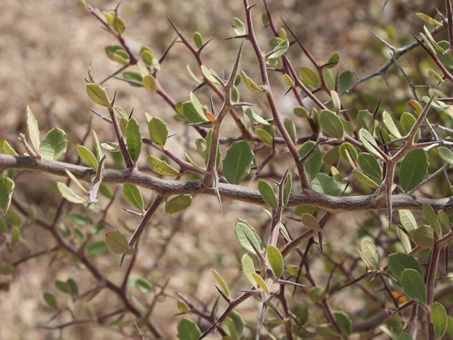This section contains entries about our botanizing in Baja California written for the UC BEE (Oct 2012 to Aug 2021)
and The UC Hive (2022-), monthly newsletters for volunteers and staff of the UC Berkeley Botanical Garden.
Click on any photo for a larger image.
BEE MAY 2019
East Cape Region
This month I want to share a few plants and views from our recent trip to the East Cape region of the peninsula, principally from around Cabo Pulmo. On our road trip in March, we spent time in La Paz, Cabo Pulmo (east Cape) and Todos Santos (west Cape). After we left the east Cape, we took the southern route, crossing the Tropic of Cancer twice as we made our way south around the tip of the peninsula, past San Jose del Cabo and Cabo San Lucas and then back north to Todos Santos. There was so much to see: lots of new plants and a constantly changing scenery as the highway climbed and descended repeatedly through the Cape Lowland Scrub. Following are just some of the highlights.

Southern end range of the Central Gulf Coast scrub near Pichilingue (east of La Paz). Almost all of the species here are typical throughout the range: Creosote (Larrea tridentata), Cardon (Pachycereus pringlei), Palo Adan (Fouquieria diguetii), Elephant trees (Bursera spp.), Limber bush (Jatropha cuneata = most of the yellow dots on the hillside).
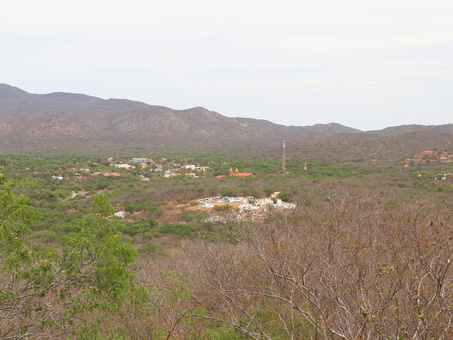
View of El Triunfo, an old mining town nestled in the foothills south of La Paz. Trees and shrubs are dense. Many of the bright green trees turned out to be Honey Mesquite (Prosopis glandulosa var. torreyana).
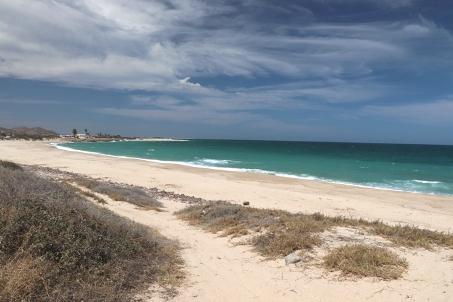
Beach view between La Ribera and Cabo Pulmo.
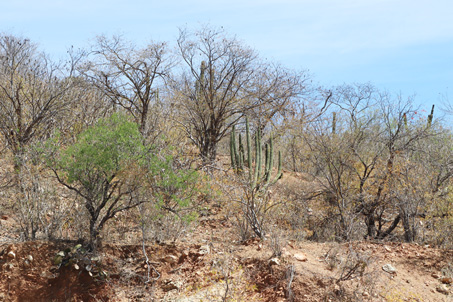
A roadcut showing vegetation taller and denser than in the desert to the north. Lots more leguminous trees and shrubs here.
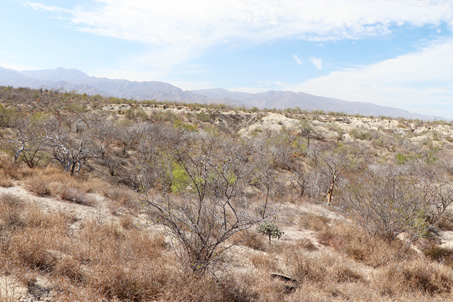
Believe it or not, this is the scrub right at the Tropic of Cancer. In the foreground is the horrible, invasive Buffelgrass (Cenchrus ciliare).
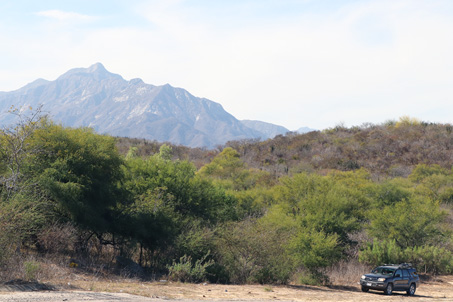
East escarpment of the Sierra de la Laguna in the distance. Arid tropical scrub of the Cape Lowlands in foreground just south of Miraflores. Here the car is at the bottom of an arroyo where the vegetation was greener than on the low hills just beyond.
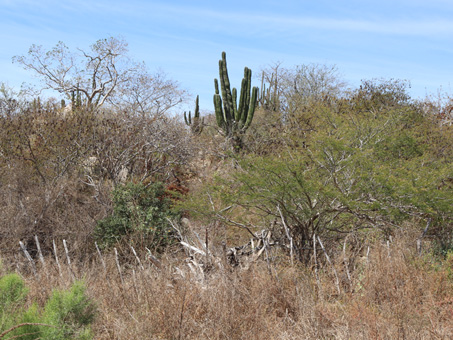
About 10 miles south of La Paz on the highway to the east Cape, the scrub has already changed dramatically, being much denser and higher. Southern species start to show up and become dominant: Cardón Barbón (Pachycereus pecten-aboriginum), Palo Verde (Parkinsona florida), Wild Fig (Ficus petiolaris), Boat-Spine Acacia/Guinole (Vachellia campechiana f. campechiana), among others.
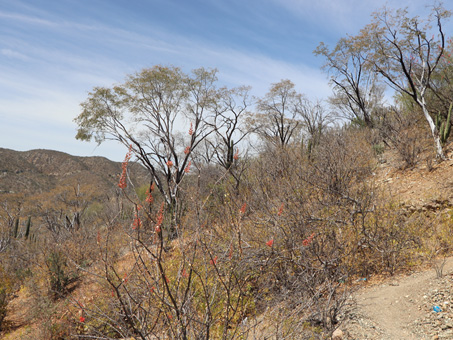
Hillside overlooking San Antonio. Palo Adán (Fouquieria diguetii, foreground, red flowers) and Palo Blanco (Lysiloma candidum, background) are abundant.

There is a lot of granite in the Cape, mixed in with the volcanics.
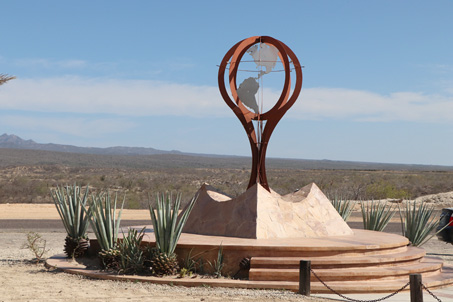
Tropic of Cancer marker.
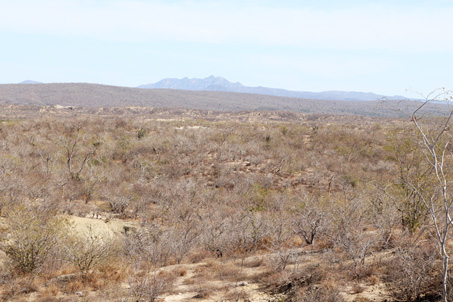
The area is one of eroded alluvial fans at about 210 m elevation.This is the dry season.

From Miraflores to San José del Cabo and then west via the new toll road, the tropcial arid scrub was very dense, with a lot of greenery in the arroyos. But then we turned back north at the Pacific coast a few kilometers north of Cabo San Lucas and this was the dramatic change we saw in the vegetation.
Cape Dogweed / Hediondilla
(Adenophyllum speciosa, Asteraceae)
Only the Spanish name properly describes the "stinky" nature of this interesting BCS endemic. Oil glands on the tips of the phyllaries and teeth of the leaves are the source of the potent odor. Some people actually find the smell pleasant while others, like me, are repulsed.
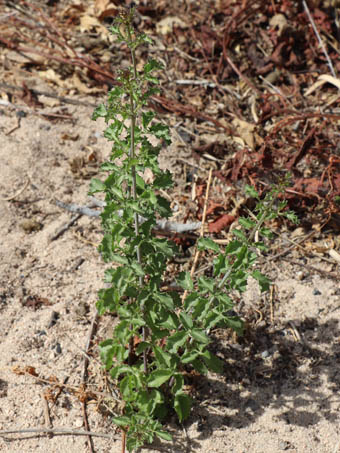
This young plant growing in the open was unusual for the area I was botanizing. Most were well hidden within the scrub and used the shrubs for support to reach up through their cover.
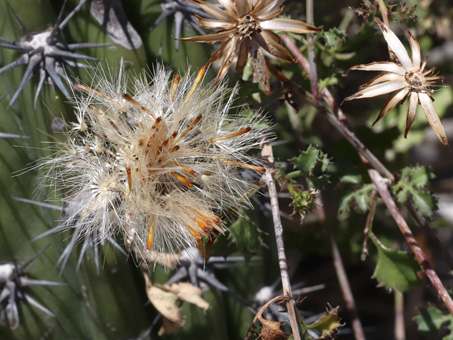
...or the dandelion-like flower heads (about 2.5 cm D) were fully blown and glowed white against the other plants.
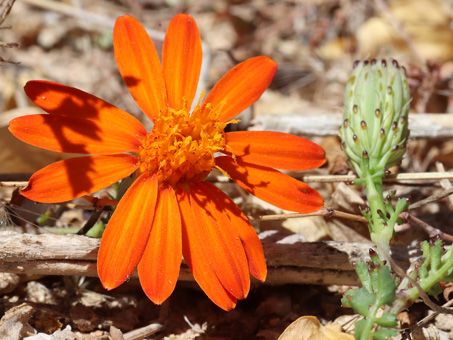
The plants were practically invisible mixed in with all of the other greenery until the the bright orange flower head (c. 3 cm D) showed up...
Arizona Wrightwort / Rama Toro
(Carlowrightia arizonica, Acanthaceae)
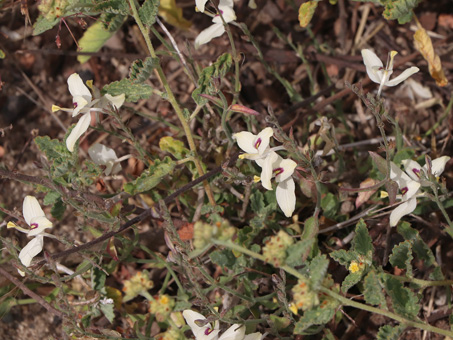
Like a flock of swans, the delicate, 1.5-2 cm W flowers appear to fly.
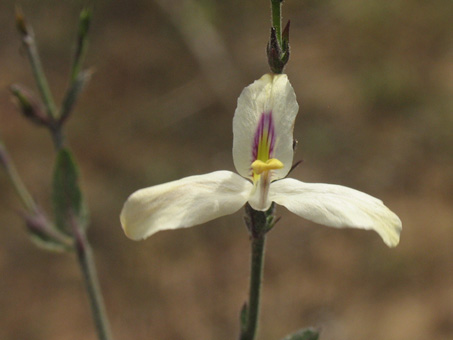
It was flowering profusely in the understory throughout the region.
Purple Scalystem / Cordoncillo
(Elytraria imbricata, Acanthaceae)

A diminutive native perennial abundant in the understory.

Flowers are 5-8 mm L, 2-lipped and arranged on spikes up to 6 cm L.
Baja California Crucifixion Thorn / Chaparro Amargoso
(Castela peninsularis, Celastraceae)
This endemic shrub is very spiny, and those spines are very sharp. It is just one of the many spiny plants I encountered in the Cape Lowland Scrub or better yet, thornscrub. Plants like this, growing densely and close together as they do, make botanizing very difficult because of the impenetrable thickets they create.
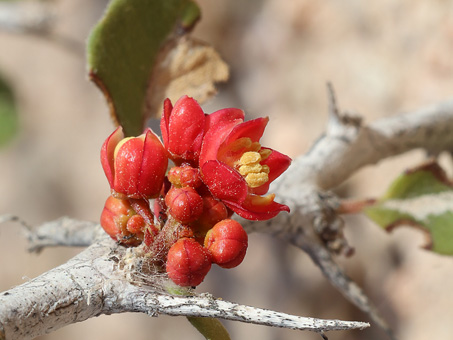
Flowers have 4 petals and are about 5-7 mm D.

The juicy fruit (a drupe) looks luscious, but its extreme bitterness gives the plant its Spanish name: bitter shrub.
Hairbrush Cactus / Cardón Barbón
(Pachycereus pecten-aboriginum, Cactaceae)
I covered this species in depth in the March Bee. On our trip, many of the plants had lots of fruit and there were fewer with buds or open flowers. The bristles of the pseudocephalium were easy to see in many of the plants we encountered.
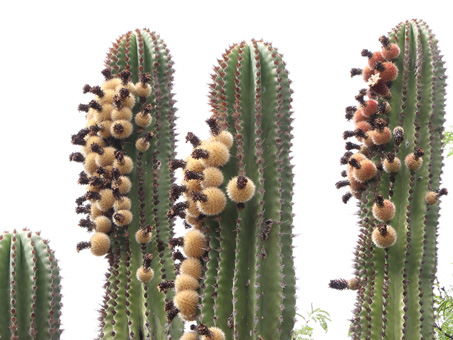
Young fruit.
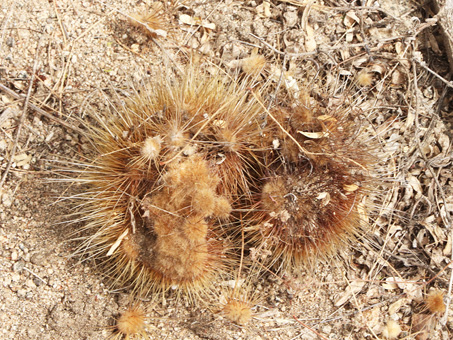
The fruit is dry and inedible. Here, the clusters of spines and bristles from the areoles are breaking apart.

Young fruit and some new flower buds and reddish bristles.
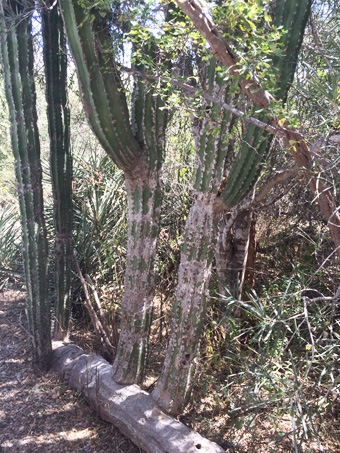
A fallen Cardón Barbón that took root and sprouted new arms, which are now growing vertically.
(Los Cabos) Nipple Cactus / Viejito
(Mammillaria armillata., Cactaceae)
This may be Mammillaria armillata. If so, it is another BCS endemic. According to Rebman et. al (2016), it isn´t very common and occurs throughout most of the Cape Region, south of La Paz. However, it was very abundant throughout the scrub of Cabo Pulmo. It could be seen poking out from under other shrubs and trees.
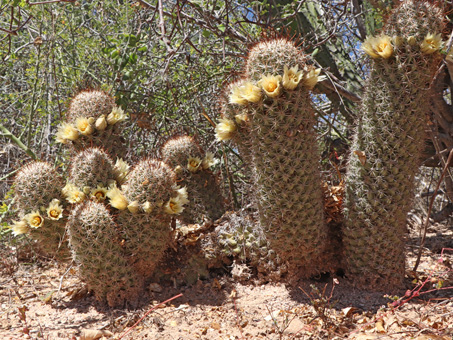
Stems were up to about 40 cm tall.
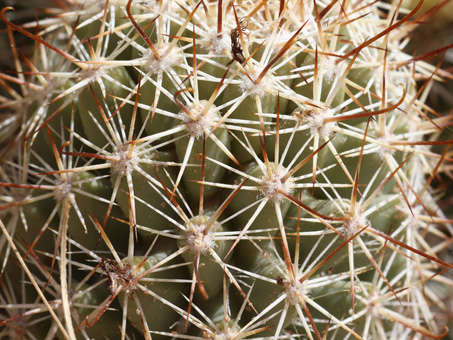
Some areoles were lanate, others not. There didn't appear to be any bristles in the axils of the tubercles.
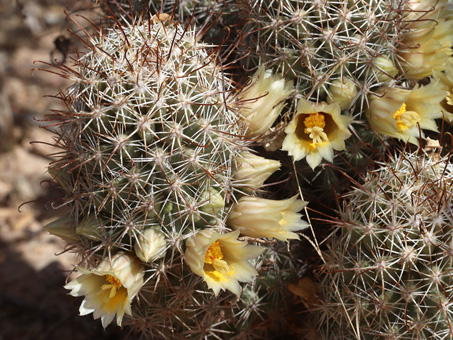
All over the area, they were flowering profusely.

Snake-Eyes / Putia
(Phaulothamnus spinescens, Achatocarpaceae)
This shrub is native to the peninsula, occuring sparsely from around Mulegé to the Cape. It is also native to Texas, and the Mexican states of Nuevo Leon, Sonora and Tamaulipas. The genus is monotypic (just one species). Another common name of this sharply spiny plant is quite fitting: Devilqueen!
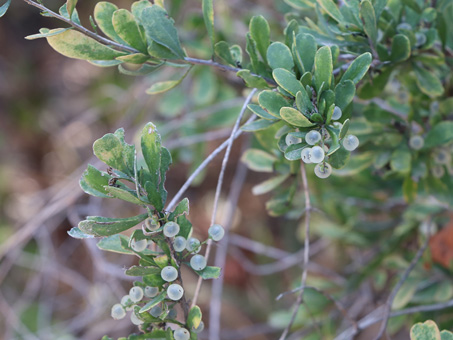
Another very spiny shrub up to 1.5 m H.
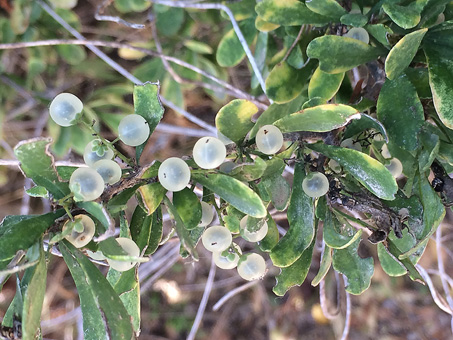
The 4-5 mm D, translucent berries have one black seed.
Cape Rose-Mallow
(Hibicus ribifolia, Malvaceae)

Like candles, the flowers of this endemic poke up through the scrub. The plant uses other species for support in its climb towards the light.
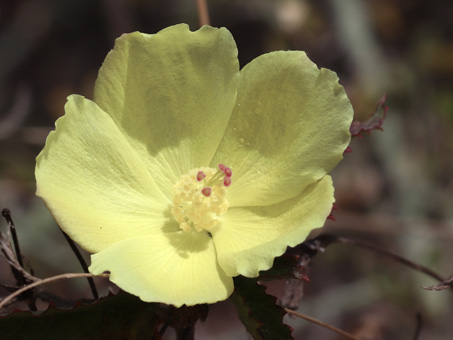

The specific epithet describes well the shallowly lobed and serrated leaves of this plant which resemble blackberry leaves (genus = Ribes).
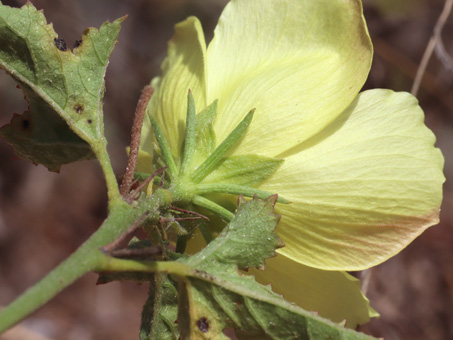
Magdalena Milkwort / Granadillo
(Polygala magdalenae, Polygalaceae)
A BCS endemic that is uncommon but found occasionally from the Sierra la Giganta near Loreto to the Cape region. These photos are from El Triunfo. Interestingly, the two times I have come across this plant in the Cape region, it was growing in a cemetary!

The fruit look a lot like those of peppergrass.

The flowers are about 7-8 mm W and resemble pea flowers.
Jicama Morning-glory / Jícama Silvestre
(Ipomoea bracteata, Convolvulaceae)
A woody, twining vine that can reach into trees at least 15 m H. We saw it mostly in the hills within the tropic zone, but it also occurred north of the Tropic of Cancer, at least as far as the hills near El Triunfo.
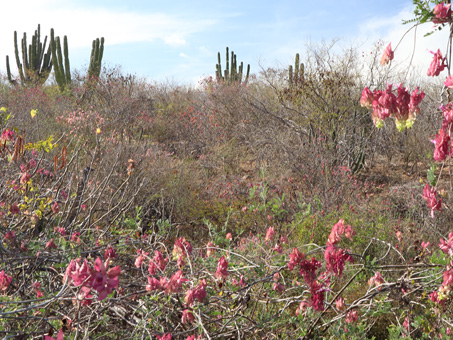
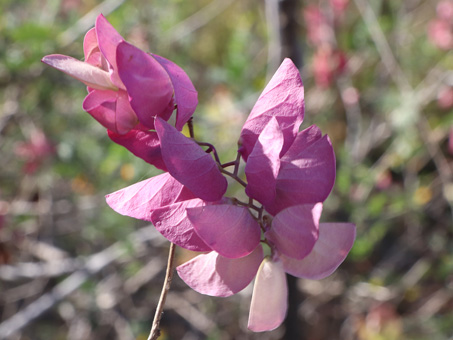
Leafy, paired bracts subtending the flowers.
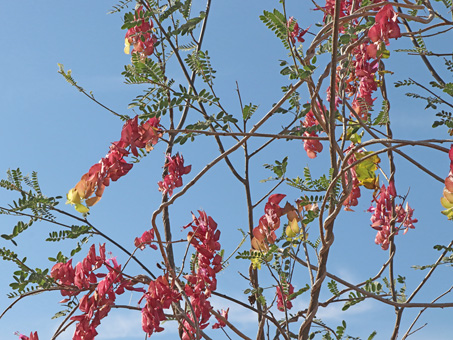
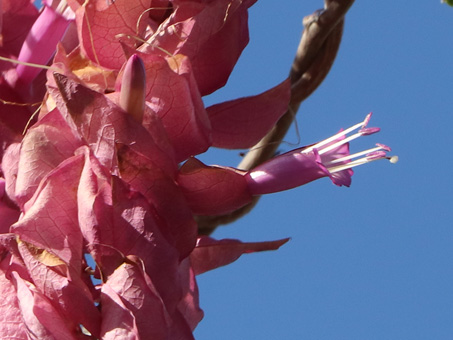
A bud emerging from the bracts and a 3-4 cm L tubular flower.
That's it for this month, and possibly the season. By the time this is posted, we'll be home in the US. Hopefully, there will be some cool plants to report on from that trip. Until then, hasta la próxima…
Debra Valov—Curatorial Volunteer
References
Rebman, J. P., J. Gibson, and K. Rich, 2016. Annotated checklist of the vascular plants of Baja California, Mexico. Proceedings of the San Diego Society of Natural History, No. 45, 15 November 2016. San Diego Natural History Museum, San Diego, CA. Full text available online.
Rebman, J. P and Roberts, N. C. (2012). Baja California Plant Field Guide. San Diego, CA: Sunbelt Publications. Descriptions and distribution.
SEINet. http://swbiodiversity.org/seinet/taxa/index.php?taxon=2971 (accessed 11/Mar/19).
Wiggins, I. L. (1980). The Flora of Baja California. Stanford University Press. Descriptions and distribution.
(click on the link for the above reference to return to your previous location on this page)





















